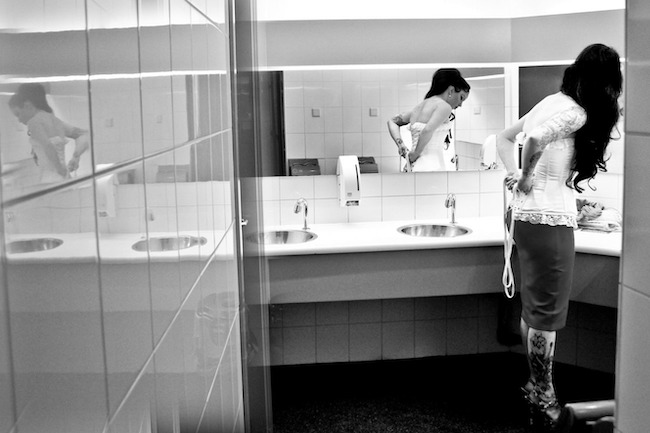L’arte contemporanea è un variegato universo costituito da differenti stili che si ispirano e rielaborano le linee guida del più recente passato, oppure un’esplorazione di tutti quei nuovi mezzi espressivi scoperti nel secolo scorso e incredibilmente evoluti nell’attualità; e poi ve ne sono altri che pur utilizzando strumenti meno propriamente legati alla manifestazione artistica così come intesa in senso più tradizionale, sono comunque in grado di dare vita ad atmosfere talmente poetiche e magiche da trasformare il risultato dell’uso di quei dispositivi in estensioni dell’emozionalità, della sensibilità e capacità di ascolto dell’autore, dando vita ad avvolgenti opere in grado di coinvolgere tanto quanto l’approccio più classico. La protagonista di cui vi racconterò oggi sceglie la fotografia per dare voce a tutte quelle parole, tutte quelle sensazioni che sono troppo immediate per essere spiegate con le parole.
Quando verso la metà dell’Ottocento cominciarono a perfezionarsi le intuizioni di Daguerre e la fotografia cominciò a prendere piede soprattutto nella ritrattistica, in quanto più accessibile alla nuova borghesia emergente che non aveva ancora i mezzi per farsi immortalare da un pittore e probabilmente non aveva neanche la cultura per comprendere il valore di un’opera d’arte, il mondo dell’arte figurativa subì un vero e proprio scossone a causa della fedeltà della riproduzione delle immagini che quel nuovo mezzo tecnologico, sebbene ancora primordiale, aveva introdotto. Di fatto più la fotografia si affermava e prendeva piede, più l’arte tradizionale cercava un modo di sfuggire a un confronto che non riusciva a reggere, ideando nuovi stili pittorici talmente discostanti dalla realtà osservata da rendere la pittura inarrivabile; l’Impressionismo, il Puntinismo, il Divisionismo e poi tutte le avanguardie del Ventesimo secolo, puntarono a oltrepassare la fedeltà alla realtà osservata per entrare in un mondo dove la creatività non potesse essere copiata o immortalata con uno scatto. Malgrado l’opposizione iniziale tuttavia, la fotografia mostrò ben preso le sue enormi potenzialità, divenendo uno strumento per raccontare istanti preziosi, frammenti di storia, ma soprattutto espressione della sensibilità e della capacità empatica dei suoi maggiori interpreti. Fu intorno agli anni Venti del Novecento che cominciarono a emergere i grandi nomi della fotografia come Henri Cartier-Bresson, Robert Doisneau, Robert Capa, André Kertész, i quali permisero al mondo di osservare la realtà del tempo ma anche di scoprire quanto all’interno del fermo immagine di un istante potesse nascondersi la poesia di un attimo; in particolar modo Doisneau, Capa e Kertész, nel periodo del secondo dopoguerra dunque in una fase di rinascita dell’umanità dalle atrocità del conflitto ma al contempo ancora destabilizzata dalle violenze a cui l’intero mondo aveva assistito, diedero vita alla fotografia umanista, in qualche modo legata al movimento letterario e filosofico dell’esistenzialismo, attraverso la quale posero al centro del punto di osservazione non più l’azione, l’evento immortalato come nella fotografia di reportage di cui fu maestro Cartier-Bresson, bensì l’essere umano, il contesto in cui viveva, le sue emozioni colte attraverso uno sguardo e portate alla luce grazie allo scatto del fotografo. Il romanticismo poetico e avvolgente di Doisneau era tanto esistenzialista quanto la capacità di Capa di puntare l’accento sulle sensazioni, sui momenti di riflessione dei militari o delle persone che decideva di ritrarre, cogliendoli nel loro momento più intenso, così come gli scatti di André Kertész si concentravano invece sulla trasformazione quasi Metafisica di tutto ciò che colpiva il suo sguardo. La fotografa olandese Andréa Lobel riadatta alla contemporaneità la capacità dei grandi maestri del passato di porre in evidenza l’interiorità dei protagonisti dei suoi scatti, optando anche lei per il bianco e nero, come se attraverso il silenzio evocato dall’alternarsi di luci e ombre in scala di grigi riuscisse ad andare a toccare i tasti più profondi, quelli meditativi non solo di se stessa bensì anche dell’osservatore che nelle atmosfere evocate sembra perdersi, richiamato dalla suggestione degli sguardi e dei frammenti di vita narrati.

Dal punto di vista della poetica espressiva, Andréa Lobel si pone in una terra di mezzo tra l’Umanesimo e la Metafisica poiché da un lato dà voce alle espressioni, spesso ammalianti e altre invece estasiate, delle sue protagoniste che sembrano quasi invitare il fruitore a entrare in quel mondo fantastico dentro cui la fotografa le colloca, dall’altro gli scenari naturali o cittadini sono sempre mostrati nella loro veste più decontestualizzata, quasi intorno a essi aleggiasse un sottile mistero, quello di un mondo fantastico sospeso a metà tra la fiaba e la dimensione onirica.
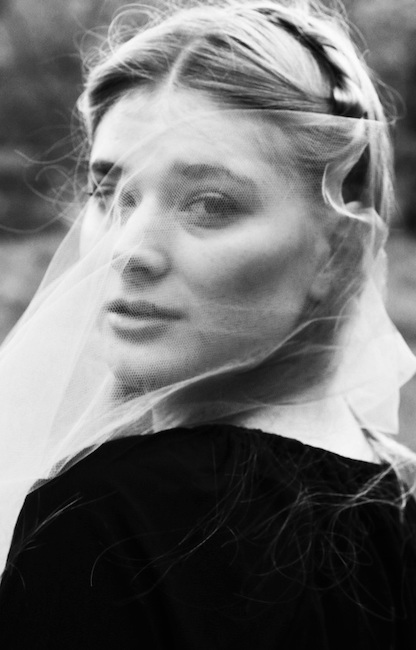
In qualche modo la fotografia diventa un modo per la Lobel di comunicare tutto quell’universo interiore che non riesce a esprimere attraverso le parole, trovando così un’interpretazione visiva a ciò che diversamente resterebbe incastrato nelle sue profondità, incapace di emergere; lo scatto non necessita di spiegazione, è immediato, non permette alla mente di interferire piuttosto si collega direttamente a quell’istinto che lascia emergere in un solo scatto un groviglio di sensazioni troppo complesse e sfaccettate per essere esplicate.
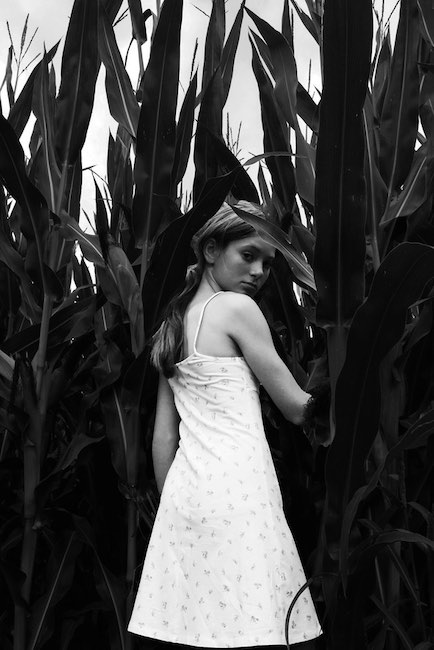
Così la fotografia diviene messo comunicativo che giunge in maniera diretta all’osservatore, il quale si sente coinvolto dalle atmosfere in scala di grigi, dalla nitidezza delle immagini e dalla sensazione di aprire la porta al mondo del sogno. Una delle caratteristiche di Andréa Lobel è quella di ritrarre le donne di spalle ma con la testa e lo sguardo rivolti all’obiettivo, trasformando così la loro presenza in un ruolo di muse ispiratrici di quel passaggio dalla realtà oggettiva a una dimensione più immaginaria, più magnetica proprio in virtù di quel senso di straniamento che le ambientazioni inducono.
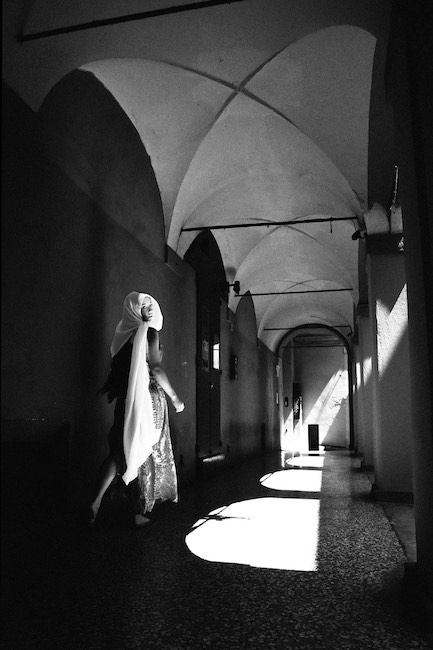
In Phyllis della serie Cities and eyes, la ragazza evoca l’immagine di una fata che suggerisce all’osservatore di seguirla per entrare nel mondo che si intuisce esservi alla fine del porticato con il soffitto a volte, come se la piccola porta che si scorge fosse l’accesso a un universo di là dove sono nascoste esperienze e verità diverse; la struttura quasi geometrica della composizione evoca l’impianto tipico della Metafisica, dove l’ordine è un imperativo per indurre l’occhio a sentirsi rassicurato ma poi viene condotto verso i significati nascosti stimolati dalla decontestualizzazione che richiamano all’enigma della realtà.
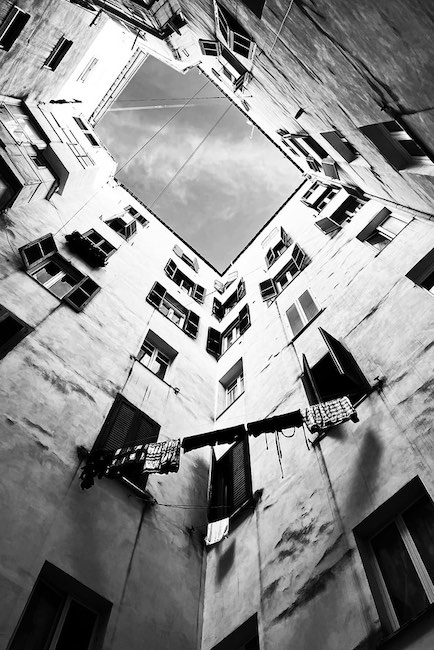
La medesima geometricità emerge dall’opera fotografica Rome della serie Cities and memories, dove Andréa Lobel dà una visione personale e originale della caratteristica dei palazzi romani, quel tendere verso l’alto provocato dalla densità abitativa che relega il cielo a farsi spazio tra i muri e i tetti, come se dalla strada l’essere umano dovesse farsi avvolgere dalla vita della città; in questo scorcio la fotografa mette in evidenza quei frammenti di vita che emergono dalle persiane aperte o semichiuse, dai panni stesi al sole che però quasi stenta a raggiungere i piani inferiori. Ciò che appare in modo chiaro è invece l’irreale silenzio evocato dall’assenza di persone, come se a essere protagonista in questo caso dovesse essere solo l’idea della vita, di tutto ciò che avviene all’interno di quei muri e che la Lobel lascia fuori con riverente discrezione.
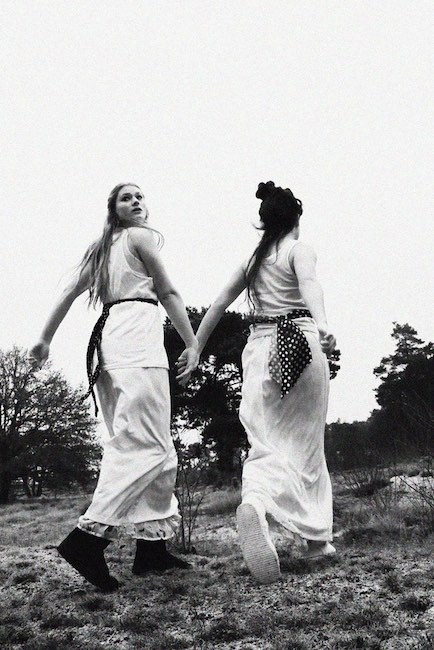
Nello scatto Comeaway, Fauve viene esaltato invece il tema della fiaba, di quell’esigenza insita nell’individuo di avere una via di fuga dalla realtà, di allontanarsi dalla contingenza per entrare in un universo in cui l’evasione si trasforma in una nuova esistenza, parallela, quantica, non meno possibile di quella contingente; il fatto che la fotografa affidi a una condottiera il compito di prendere per mano Fauve, la donna che si volta verso l’osservatore quasi a voler in qualche modo restare attaccata alla sua quotidianità, sembra essere una metafora dell’uomo moderno che pur essendo concentrato sulla propria individualità, di fatto ha bisogno di appartenere a un gruppo, a un insieme dentro cui sentirsi protetto e rassicurato. Al contrario, la scelta di uscire dal coro necessita un coraggio che la protagonista dello scatto sembra non avere dunque la presenza dell’altra figura è funzionale a permetterle di fare quel salto nel buio che probabilmente la porterà verso la dimensione più affine alla propria personalità e probabilmente verso un futuro migliore.
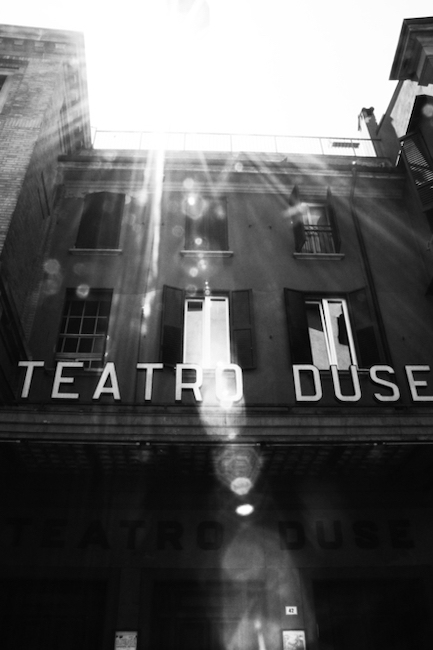
Andréa Lobel, nata a L’Aia, ha studiato all’Accademia di Fotografia e alla Scuola d’Arte e Design dei Paesi Bassi. Attualmente partecipa a mostre d’arte in Europa – Francia, Regno Unito, Spagna, Italia – e le sue opere fotografiche sono state premiate in varie manifestazioni.
ANDRÉA LOBEL-CONTATTI
Email: loftlobel@gmail.com
Sito web: www.andrealobel.nl/
Linkedin: www.linkedin.com/in/andrealobel/
Instagram: www.instagram.com/andrealobel/
The silent moments of Andréa Lobel’s evocative photographic works, when black and white suspends the passing of time
Contemporary art is a varied universe made up of different styles that are inspired by and re-elaborate the guidelines of the more recent past, or an exploration of all those new means of expression discovered in the last century and incredibly evolved in the present day; and then there are others that, while using instruments less closely related to artistic manifestation as understood in the more traditional sense, are nonetheless able to give life to atmospheres so poetic and magical that they transform the result of the use of those devices into extensions of the author’s emotionality, sensitivity and ability to listen, giving life to enveloping artworks that are able to involve as much as the more classic approach. The protagonist I will tell you about today chooses photography to give voice to all those words, all those feelings that are too immediate to be explained with words.
When Daguerre‘s intuitions began to be perfected in the mid 19th century and photography began to gain a foothold especially in portraiture, as it was more accessible to the newly emerging bourgeoisie who did not yet have the means to have themselves immortalised by a painter and probably did not even have the culture to understand the value of a work of art, the world of figurative art underwent a real shake-up due to the fidelity of image reproduction that this new, albeit still primordial, technological medium had introduced. In fact, the more photography became established and took hold, the more traditional art sought a way to escape a confrontation it could not withstand, devising new pictorial styles that were so far removed from observed reality as to make painting unattainable; Impressionism, Pointillism, Divisionism and then all the avant-gardes of the 20th century aimed to go beyond fidelity to observed reality and enter a world where creativity could not be copied or immortalised with a snapshot. Despite the initial opposition, however, photography soon showed its enormous potential, becoming a tool for recounting precious moments, fragments of history, but above all an expression of the sensitivity and empathic ability of its greatest interpreters. It was around the 1920s that began to emerge the great names of photography, such as Henri Cartier-Bresson, Robert Doisneau, Robert Capa and André Kertész, who allowed the world to observe the reality of time but also to discover how much the poetry of a moment could be hidden within the still image of an instant; especially Doisneau, Capa and Kertész, in the period after the Second World War, therefore in a phase of rebirth of humanity from the atrocities of the conflict, but at the same time still destabilised by the violence that the entire world had witnessed, gave life to Humanist photography, in some way linked to the literary and philosophical movement of Existentialism, through which they no longer placed at the centre of the point of observation the action, the event immortalised as in the reportage photography of which Cartier-Bresson was the master, but rather the human being, the context in which he lived, his emotions captured through a glance and brought to light thanks to the photographer’s shot.
Doisneau‘s poetic and enveloping romanticism was as existentialist as Capa‘s ability to focus on the feelings, on the moments of reflection of the soldiers or people he decided to portray, capturing them in their most intense moment, just as André Kertész‘s shots focused instead on the almost metaphysical transformation of everything that caught his eye. The Dutch photographer Andréa Lobel re-adapts to contemporary times the ability of the great masters of the past to highlight the interiority of the protagonists of her shots, also opting for black and white, as if through the silence evoked by the alternation of light and shade in greyscale she were able to touch the deepest keys, the meditative ones not only of herself but also of the observer who seems to lose himself in the atmospheres evoked, drawn by the suggestion of the glances and fragments of life narrated. From the point of view of expressive poetics, Andréa Lobel places herself in a middle ground between Humanism and Metaphysics, since on the one hand she gives voice to the expressions, often bewitching and at other times enraptured, of her protagonists who almost seem to invite the viewer to enter the fantasy world in which she places them, on the other hand, the natural or urban settings are always shown in their most decontextualised guise, almost as if a subtle mystery hovers around them, that of a fantasy world suspended somewhere between a fairy tale and a dreamlike dimension. In some way, photography becomes a way for Lobel to communicate all that inner universe that she is unable to express through words, thus finding a visual interpretation of what would otherwise remain stuck in its depths, unable to emerge; the shot does not need an explanation, it is immediate, it does not allow the mind to interfere, rather it connects directly to that instinct that permit a tangle of sensations to emerge in a single shot, sensations that are too complex and multifaceted to be explained. Thus photography becomes a communicative medium that reaches out directly to the observer, who feels involved by the greyscale atmospheres, the sharpness of the images and the sensation of opening the door to the world of dreams.
One of Andréa Lobel‘s characteristics is that of portraying women with their backs turned, but with their head and gaze facing the lens, thus transforming their presence into the role of inspiring muses in that passage from objective reality to a more imaginary dimension, more magnetic precisely because of the sense of estrangement that the settings induce. In Phyllis of the Cities and eyes series, the girl evokes the image of a fairy suggesting the viewer to follow her in order to enter the world that one perceives to be at the end of the arcade with the vaulted ceiling, as if the small door that can be glimpsed were the access to a universe beyond where different experiences and truths are hidden; the almost geometric structure of the composition evokes the typical layout of Metaphysics, where order is an imperative to induce the eye to feel reassured but is then led towards the hidden meanings stimulated by decontextualisation that recall the enigma of reality. The same geometricity emerges in the photographic work Rome from the series Cities and memories, where Andréa Lobel gives a personal and original vision of the characteristic of Roman buildings, that upward tendency caused by the density of housing that relegates the sky to making space between the walls and roofs, as if from the street the human being had to be enveloped by the life of the city; in this view, the photographer highlights those fragments of life that emerge from the open or half-closed shutters, from the clothes hung out in the sun, which, however, almost hardly reaches the lower floors.
What instead appears clearly is the unreal silence evoked by the absence of people, as if the only protagonist in this case should be the idea of life, of everything that happens inside those walls and that Lobel leaves out with reverent discretion. In the shot Comeaway, Fauve, on the other hand, is exhalted the theme of the fairy tale, of that need inherent in the individual to have an escape route from reality, to get away from contingency in order to enter a universe in which evasion is transformed into a new existence, parallel, quantum, no less possible than the contingent one; the fact that the photographer entrusts to a leader the task of taking Fauve by the hand, the woman who turns towards the observer almost as if she wanted in some way to remain attached to her everyday life, seems to be a metaphor for modern man who, although focused on his own individuality, in fact needs to belong to a group, to an ensemble within which he feels protected and reassured. On the contrary, the choice to step out of the choir requires a courage that the protagonist of the shot seems not to have, so the presence of the other figure is functional in allowing her to take that leap into the dark that will probably lead her towards the dimension most akin to her own personality and probably towards a better future. Andréa Lobel, born in The Hague, studied at the Academy of Photography and the School of Art and Design in The Netherlands. She currently participates in art exhibitions in Europe – France, United Kingdom, Spain, Italy – and her photographic works have been awarded at various events.


